Kids love the outdoors. Given any opportunity, they jump in the dirt with abandon, marvel at little bugs and creatures, collect rocks and flowers, and make themselves right at home. More and more frequently, I am hearing about things like Nature Deficit Disorder and how children are spending more time plugged in and less time tuned in to the outdoors. Diagnoses of ADD, ADHD, Sensory Integration Disorder and Autism Spectrum Disorder are on the rise, and research abounds linking this to our increasingly indoor society. The good news, is that this is not a hopeless situation.
Human beings need time outside in nature. It really is our native habitat. I realize that not every family is made up of wild outdoorspeople and naturalists like ours, but you really don’t have to go out on wild camping excursions or long grueling backpacking trips to get your children outside. Nature is all around us. In parks, alleyways, backyard brooks, ravines, bike trails, county and state parks, and even in little cracks in the sidewalk where gardens of weeds pop up. Bugs, slugs, snails, raccoons, deer, wild turkeys and bats can all be found nearby, whether you make your home in a city, suburbia, or the countryside. I am encouraged by urban outdoor programs, like our local Nearby Nature and Whole Earth Nature School offering programs to help parents find an outlet for their kids to tune in to the natural world we live in. I hear about more and more schools having outdoor walk times built into their curriculum and taking older children to week-long sessions at outdoor schools. Parks and arboretums oftentimes offer guided walks and programs with activities and crafts. Ask around, and you’re sure to find something offered in your community.
Getting kids interested in nature is key. The more you show interest, the more likely their interest will be sparked. I have heard quite a few parents say that their kids don’t like being outside, and they don’t want to make them unhappy. My thoughts on this will perhaps go against popular parenting sentiments of today, but I feel strongly that it is our job to do the best thing for our children and to teach them to grow into adults who know how to create their own happiness, not expect it from people around them. It is not our job to make them happy. They might complain and display apathy or outright resistance, but once you get them out there immersed in outdoor spaces, even dirt-loathing couch potatoes will start having fun. They can’t help but notice all the little bugs and critters, and eventually, they will start playing in the dirt or splashing in a puddle. I think it’s in their wiring.
If you have a child with special needs, ADHD, Autism spectrum disorder, or many other challenges children and their parents face, consider outdoor time as a very inexpensive form of therapy. When my son was diagnosed by the local school district with Autism spectrum disorder in pre-school, a whole array of therapies and treatments were presented to us, none of which were covered by our health insurance, and none of which we could afford. We were fortunate to have access to many services through the school district for free, but we wanted to do more to help our son. We found a specialist who our insurance covered as a regular pediatrician, and she was the one who first told us about the concept of Nature Deficit Disorder and Richard Louv’s book, Last Child in the Woods. She said she could tell we were outdoorspeople, and that what would help our son the most was to do more of what we were already doing. She said if we took him outside as much as possible, it would be of great benefit. We took her advice and stepped up the camping and day excursions outdoors. Every chance I got, I sent him and his sister to outdoor nature programs with local organizations on no-school days and during the summer. Many of these organizations had wonderful scholarship programs that made this possible. At the same time, we put him on a gluten-free casein-free diet, and they did some focused work with him at school on his social and sensory issues. Do you know what? He improved dramatically! I’m not saying the outdoor time was THE only thing that helped, but it was certainly a big help.
So, I’ve said a fair amount about how connecting kids with nature is good for the kids, but it is also important to note how it is good for the earth. It is unlikely that a human being with no personal connection or positive experiences with nature is going to feel a sense of responsibility for environmental stewardship. Recycling, reducing pollution, using earth-friendly products, preserving wild places, and supporting sustainable agriculture are all optional at this point. Choosing the options that have positive impacts on the environment is not inherent, it is learned. Think of your child’s outdoor time and activities as an environmental education. This may or may not be something they learn in school, and much of it is simply first-hand experience. Taking your child on a walk through a park may one day inspire them to help shape laws preserving National Park lands. Letting your child play in the dirt in the vacant lot next door may result in them leading community garden programs in inner-cities as an adult. You never know what experiences, however great or small, will shape them into the adults they will become. They are, after all, the ones who will inherit the earth after we are long gone.
With all of the nature education I have tried to provide my children, they are turning out to be some very nature-centric little people. They are comfortable and happy in the outdoors, and I see a lot of thought go into being caretakers. One of my proud parenting moments was when this summer, they discovered a colorful garden spider building a web in our herb bed beside the house. My son recognized that it was an orb spider, and they named her Orbsy Orbie Orbarella. Instead of asking to watch movies, they went outside every day to watch Orbarella and get updates on her happenings. That spider was the first thing they wanted to show everyone who came around. Their teacher came out for a home visit before school started, and they ran over, beaming, to introduce her to their little Arachnid friend.
One day, Orbarella disappeared, and not long after, the kids noticed this red sphere hanging in a network of webbing in a clump of wheat near her old web. They put two and two together that this was her egg sac, and devoted their time to protecting it. They said they wanted more orb spiders in our garden to eat the mosquitoes. As the winter set in, we moved the egg sac to a rosemary bush in the garden for more protection. What impressed me most about all this was that they were not afraid of the spider, they liked the spider and gave it a name, they could identify the spider, and they felt a sense of responsibility to protect her and her offspring.
I feel that I can rest easily knowing my kids are going to take good care of the earth, and they understand that the earth will take good care of them. They know it will always be a place to turn to for peace and renewal, no matter how crazy the world around them gets.
Ah, Nature…it’s poor-man’s therapy.
Resources:
Last Child in the Woods by Richard Louv
The Geography of Childhood by Gary Paul Nabhan and Stephen Trimble
Hands-on Nature by The Vermont Institute of Natural Science
Nearby Nature: http://www.nearbynature.org/
ReWild Eugene: http://www.rewild.com/
Whole Earth Nature School: http://www.wholeearthnatureschool.com/
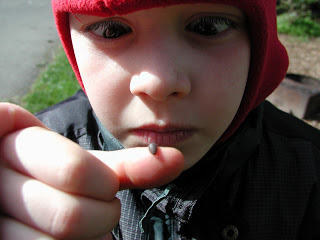
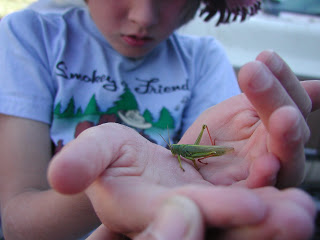
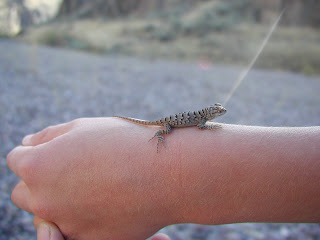
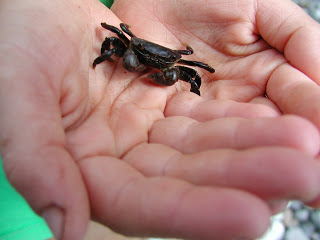
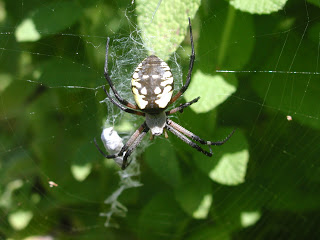
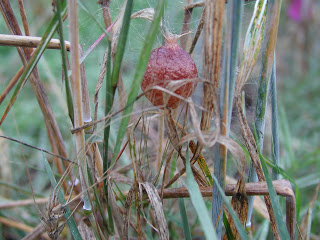
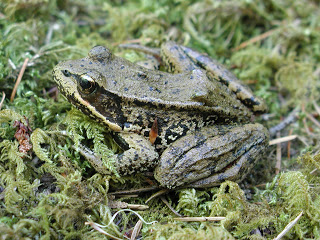
When I was a kid – an indoors-loving, book-reading, socially-inept kid – my mom would simply kick me out of the house and say, "I'll see you in three hours." I wasn't allowed back in. Sometimes I took my book with me and read outside. Other times I explored the world around me. It was a good thing. And it's something I'm going to start doing with my indoors-loving, book-reading, socially-inept daughter.
Right on! On rainy days up in Washington, I used to get sent outside in my rain gear with a pocket full of red-hot cinnamon candies. It was so good for me. I love seeing my kids go out in their raingear now to dig "creeks" in the mud.
Lara, thank you so much for sharing this with us. It is hard to get out sometimes living a busy modern life, but there is wildlife right in our backyards. I crave the outdoors as much as my daughter does and sometimes getting wet and dirty really feels like therapy.